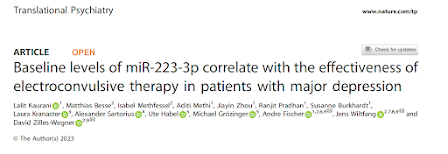Out on PubMed, from investigators in Germany, is this study:
Baseline levels of miR-223-3p correlate with the effectiveness of electroconvulsive therapy in patients with major depression.Kaurani L, Besse M, Methfessel I, Methi A, Zhou J, Pradhan R, Burkhardt S, Kranaster L, Sartorius A, Habel U, Grözinger M, Fischer A, Wiltfang J, Zilles-Wegner D.Transl Psychiatry. 2023 Sep 13;13(1):294. doi: 10.1038/s41398-023-02582-4.
PMID: 37699900PMID: 37699900
The abstract is copied below:
There is a strong medical need to develop suitable biomarkers to improve the diagnosis and treatment of depression, particularly in predicting response to certain therapeutic approaches such as electroconvulsive therapy (ECT).
MicroRNAs are small non-coding RNAs that have the ability to influence the transcriptome as well as proteostasis at the systems level. Here, we investigate the role of circulating microRNAs in depression and response prediction towards ECT. Of the 64 patients with treatment-resistant major depression (MDD) who received ECT treatment, 62.5% showed a response, defined as a reduction of ≥50% in the MADRS total score from baseline. We performed smallRNA sequencing in blood samples that were taken before the first ECT, after the first and the last ECT. The microRNAome was compared between responders and non-responders. Co-expression network analysis identified three significant microRNA modules with reverse correlation between ECT- responders and non-responders, that were amongst other biological processes linked to inflammation. A candidate microRNA, namely miR-223-3p was down-regulated in ECT responders when compared to non-responders at baseline. In line with data suggesting a role of miR-223-3p in inflammatory processes we observed higher expression levels of proinflammatory factors Il-6, Il-1b, Nlrp3 and Tnf-α in ECT responders at baseline when compared to non-responders.
ROC analysis of confirmed the diagnostic power of miR-223-3p demarcating ECT-responders from non-responder subjects (AUC = 0.76, p = 0.0031). Our data suggest that miR-223-3p expression and related cytokine levels could serve as predictors of response to ECT in individuals with treatment-resistant depressive disorders.
And from the text:
Here is a very sophisticated, well presented study looking for a blood biomarker of ECT response. Whether or not these particular MicroRNA changes, along with the associated cytokine patterns, will ultimately prove to be clinically useful is too early to tell. But this is an exciting approach, and these investigators deserve big kudos for their efforts.We hope this work will be replicated and expanded upon.
Until that happens, we will need to continue to predict ECT response the old fashioned way: by clinical features and personal and family history.
We are already very good at this, but far from perfect, and increased precision is a worthy goal.






Comments
Post a Comment